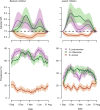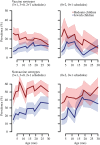Epidemiological Markers for Interactions Among Streptococcus pneumoniae, Haemophilus influenzae, and Staphylococcus aureus in Upper Respiratory Tract Carriage
- PMID: 26704617
- PMCID: PMC4837906
- DOI: 10.1093/infdis/jiv761
Epidemiological Markers for Interactions Among Streptococcus pneumoniae, Haemophilus influenzae, and Staphylococcus aureus in Upper Respiratory Tract Carriage
Abstract
Background: Cocolonization by Streptococcus pneumoniae and Haemophilus influenzae among children has been noted in numerous studies, as has an inverse relationship involving colonization with these species and Staphylococcus aureus. Interactions among these pathogens could mediate unanticipated outcomes of clinical interventions, including changes in H. influenzae and S. aureus disease incidence following pneumococcal vaccine introduction. However, it remains unclear whether cocolonization patterns represent true interspecies interactions or whether they result from confounding factors.
Methods: We investigated polymicrobial carriage using longitudinal data from 369 Bedouin children and 400 Jewish children in Israel who were enrolled in a 7-valent pneumococcal conjugate vaccine (PCV7) trial. Children were swabbed 10 times between 2 and 30 months of age.
Results: The pathogens followed distinct age and seasonal distributions, but polymicrobial carriage associations persisted after controlling for these and other confounding factors. Receipt of PCV7 resulted in pneumococcal serotype replacement but did not influence total carriage of S. pneumoniae, H. influenzae, or S. aureus.
Conclusions: The fact that S. pneumoniae, H. influenzae, and S. aureus polymicrobial carriage patterns do not result from confounding by age and season supports the idea of active interspecies interactions. However, pneumococcal serotype replacement may prevent changes in H. influenzae and S. aureus carriage among PCV7 recipients.
Keywords: Haemophilus influenzae; Staphylococcus aureus; Streptococcus pneumoniae; pneumococcal conjugate vaccine; serotype replacement.
© The Author 2015. Published by Oxford University Press for the Infectious Diseases Society of America. All rights reserved. For permissions, e-mail journals.permissions@oup.com.
Figures



References
-
- Kopterides P, Falagas ME. Potential consequences of the pneumococcal conjugate vaccine. N Engl J Med 2006; 355:95–6. - PubMed
-
- Regev-Yochay G, Bogaert D, Malley RI et al. . Does pneumococcal conjugate vaccine influence Staphylococcus aureus carriage in children? Clin Infect Dis 2008; 47:289–90. - PubMed
-
- Bogaert D, Van Belkum A, Sluijter M et al. . Colonisation by Streptococcus pneumoniae and Staphylococcus aureus in healthy children. Lancet 2004; 363:1871–2. - PubMed
Publication types
MeSH terms
Substances
Grants and funding
LinkOut - more resources
Full Text Sources
Other Literature Sources
Medical

